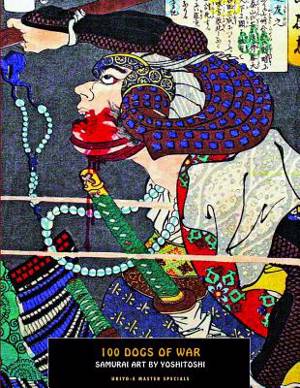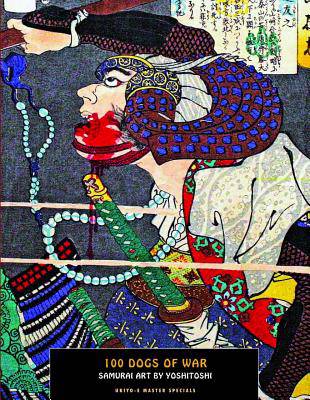
- Afhalen na 1 uur in een winkel met voorraad
- Gratis thuislevering in België vanaf € 30
- Ruim aanbod met 7 miljoen producten
- Afhalen na 1 uur in een winkel met voorraad
- Gratis thuislevering in België vanaf € 30
- Ruim aanbod met 7 miljoen producten
Zoeken
Omschrijving
Tsukioka Yoshitoshi's triptychs and portrait series of the 1860s were predominatly musha-e ("warrior prints"), often with added mythological elements, and invariably drawn from Japanese military history, mostly from the 12th to 16th centuries. Yoshitoshi's major musha-e series, in terms of both its scope and its dynamic visual experimentation, remains Kaidai hyaku senso, or 100 Dogs Of War.
Yoshitoshi was reputedly driven to create this series in 1868 after witnessing first-hand the bloody Battle of Ueno, a decisive clash of the civil war in Japan. Although inspired by recent events, the series again depicted warriors from Japanese history, showing some clasping bloody severed heads as trophies of war, others with their own viscera spilling out from the "belly cut" of seppuku (ritual suicide), others in the heat of battle firing guns, hurling spears, wielding swords or dodging bullets. Every aspect of war is represented. There are 65 known completed prints from the series, and several surviving drawings and sketches for designs which apparently never reached fruition; failure to complete the set is attributed both to censorship and to the nervous breakdown which Yoshitoshi reportedly experienced in 1869, an event which resulted in his virtual disappearance from the ukiyo-e scene for the following two years.
This Ukiyo-e Master Special edition of Yoshitoshi's 100 Dogs Of War contains not only Yoshitoshi's full set of 65 completed battle prints, reproduced in full-size and full-colour, but also several fascinating preparatory drawings for unfinished designs. The collection also features an extensive illustrated introduction on Yoshitoshi's warrior prints from 1853 to 1889, bringing the total number of colour reproductions in the book to over 90.
Ukiyo-e Master Specials: presenting individual art series by the greatest print-designers and painters of Edo-period and Meiji-period Japan.
Yoshitoshi was reputedly driven to create this series in 1868 after witnessing first-hand the bloody Battle of Ueno, a decisive clash of the civil war in Japan. Although inspired by recent events, the series again depicted warriors from Japanese history, showing some clasping bloody severed heads as trophies of war, others with their own viscera spilling out from the "belly cut" of seppuku (ritual suicide), others in the heat of battle firing guns, hurling spears, wielding swords or dodging bullets. Every aspect of war is represented. There are 65 known completed prints from the series, and several surviving drawings and sketches for designs which apparently never reached fruition; failure to complete the set is attributed both to censorship and to the nervous breakdown which Yoshitoshi reportedly experienced in 1869, an event which resulted in his virtual disappearance from the ukiyo-e scene for the following two years.
This Ukiyo-e Master Special edition of Yoshitoshi's 100 Dogs Of War contains not only Yoshitoshi's full set of 65 completed battle prints, reproduced in full-size and full-colour, but also several fascinating preparatory drawings for unfinished designs. The collection also features an extensive illustrated introduction on Yoshitoshi's warrior prints from 1853 to 1889, bringing the total number of colour reproductions in the book to over 90.
Ukiyo-e Master Specials: presenting individual art series by the greatest print-designers and painters of Edo-period and Meiji-period Japan.
Specificaties
Betrokkenen
- Illustrator(s):
- Uitgeverij:
Inhoud
- Aantal bladzijden:
- 104
- Taal:
- Engels
- Reeks:
Eigenschappen
- Productcode (EAN):
- 9781840683165
- Verschijningsdatum:
- 30/06/2014
- Uitvoering:
- Paperback
- Formaat:
- Trade paperback (VS)
- Afmetingen:
- 213 mm x 277 mm
- Gewicht:
- 521 g

Alleen bij Standaard Boekhandel
+ 55 punten op je klantenkaart van Standaard Boekhandel
Beoordelingen
We publiceren alleen reviews die voldoen aan de voorwaarden voor reviews. Bekijk onze voorwaarden voor reviews.










